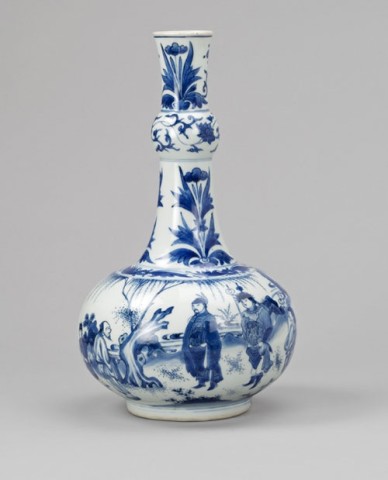Of globular form with tall tapering neck interrupted by a bulb, below the flaring mouth-rim, and supported on short straight foot, painted around the exterior in rich cobalt blue tones with an official, wearing his badge of office, dressed in long robes and behind him his two helmet clad attendants both dressed in long boots and holding thin spears in their hands, two more figures coming forward, one an older bearded man dressed in robes, behind him a younger male holding a lotus flower, all standing underneath the thin hanging branches of a willow tree in a rocky landscape, the scene is divided by rockwork, swirling mist, and what appears to be a painted screen, around the shoulder a continuous band of flower-heads with long leaves on either side, set within double blue lines, the tall neck, with two bands, the lower painted with three stylised iznik-like tulips, and the upper with two smaller iznik-like tulips separated by the bulb, painted with scrolling lotus, double concentric blue lines around the rim of the foot and the base glazed.
Provenance
Skelmorlie Castle, Ayrshire, Scotland.
Literature
An almost identical vase part of PhD Hultmark’s collection was exhibited in Sweden by the family in the following exhibitions:
Hultmarks Samling, Stockholm 1942 Exhibition in Kungliga Akademien for de fria konsterna, no 399
A very similar vase, although with different figures on the lower section is in the Butler Family Collection. See Sir Michael Butler et al., Seventeenth-Century Chinese Porcelain from the Butler Family collection, 1990, no. 38. Butler feels that this group of vases were only made during the Chongzheng period.
For two more examples of this type of bottle, given by Sir A.W. Franks, see Ming Ceramics in the British Museum by Jessica Harrison-Hall, published 2001 by the British Museum press, no 12:80-12:81, as well as an example of what is believed to be the prototype of this particular shape, Harrison-Hall shows an Iznik bottle dating to ca 1560-1580, see no 12:80, 12:81, fig 1. Quote Harrison-Hall: “Tulips were introduced to Holland from Turkey via Vienna between 1573 and 1587. However, between 1634 and 1637 speculative prices for tulip bulbs ran so high that a rare variety could fetch a fortune in florins. About this time the tulip begins to appear as a decorative motif on both Delft and Chinese porcelains.”
For another very similar example see Christiaan J.A. Jorg in collaboration with Jan van Campen,Chinese Ceramics in the Collection of the Rijksmuseum, Amsterdam, published by Phillip Wilson and the Rijksmuseum Amsterdam, London and Amsterdam, 1997, pl 63, p 76. Quote Jorg: “The tulip was a topical motif and is probably what is meant by the ‘Dutch flowers and leaves’ mentioned by the Batavia government in 1635, 1637 and 1639 to indicate the type of decoration they did not want any more, since it was not exotic enough.”
For a further example see the Topkapi Saray Museum, no 1627 TKS, 15/4433, p 810, Volume II, but this example has been reduced in height and has Ottoman silver mounts added.
A vase of this type with a similar decoration appears in a Dutch still-life probably painted before 1646, which is illustrated by A. Spriggs, in “Oriental Porcelain in Western Paintings 1450 – 1700”, Transactions of the Oriental Ceramic Society, Vol 36, 1964 – 66, pl. 72c.
For another pair see also Gordon Lang, The Wrestling Boys – An Exhibition of Chinese and Japanese ceramics from the 16th to the 18th century in the collection at Burghley House, Burghley House Preservation Trust Ltd. Stamford, Lincolnshire, 1983, where Lang writes; “"The Devonshire Schedule includes "A pair of Large double-neck Bottles blue and white about fifteen inches high some figures on them".
This form of bottle is probably the "knotted flask" ordered from Formosa in 1640 identified by T. Volker in Porcelain and the Dutch East India Company, p. 90. A similar bottle appears in a still life by William Kalf (1619-93) almost certainly painted before 1646. Illustrated by Spriggs, Oriental Porcelain in Western Paintings, plate 72c.
The '1688' Inventory was drawn up by Culpeppar Tanner, personal secretary to the Fifth Earl of Devonshire. It is the earliest known inventory containing Japanese and Blanc de Chine porcelain. The former comprises mainly Arita polycrome wares decorated in the Kakiemon palette. The second and equally important Inventory included in the Last Will and Testament of Elizabeth, dowager Countess of Devonshire (dated 1690). In this document she bequeathed the contents of her bedchamber and closet to her daughter Anne, Countess of Exeter, wife of the Fifth Earl. This Inventory, which for the sake of clarity Gordon Lang refers to as the "Devonshire Schedule" lists over one hundred and fifty pieces of porcelain."”

